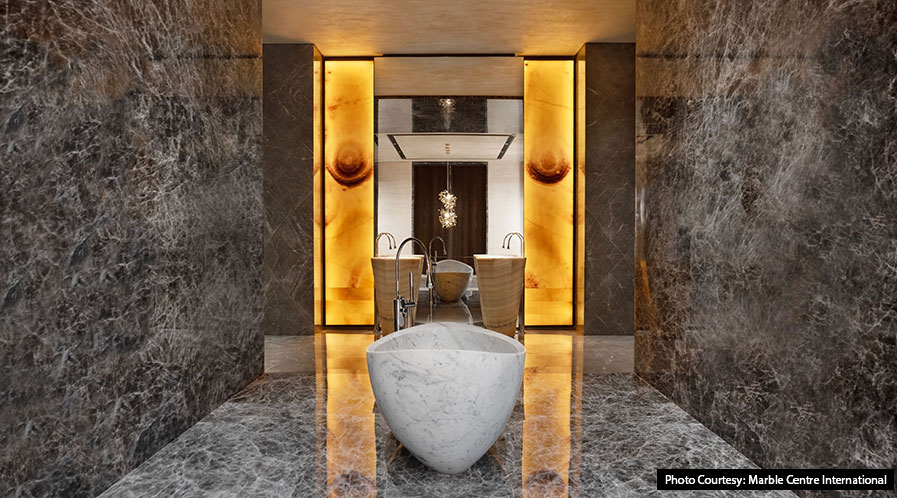Transcending Trends: Embracing Marble in Washroom Design
Marble is a material that transcends trends and styles, making it an excellent choice for bathroom design. Whether aesthetics lean towards classic, contemporary, or something in between, marble seamlessly integrates into any decor scheme, adding a touch of timeless class, writes Mrinmoy Dey
The washroom has turned into a personal sanctuary, a place of rejuvenation and relaxation. When it comes to crafting a luxurious and inviting atmosphere, few materials can rival the timeless elegance of marble. Marble is a natural stone that has been used in architecture and design for centuries. The intricate veining and a range of colours, from pristine whites to deep, rich tones, exude sophistication and impart a sense of calm and tranquillity.
Applications in Washrooms
Natural marble is an excellent choice for creating luxurious and elegant bathrooms, offering a timeless and opulent aesthetic that can transform any space into a spa-like retreat. Marble’s enduring appeal ensures that a marble-clad bathroom remains stylish for years to come, and its versatility allows designers to craft custom looks by using it for flooring, vanity tops, wall panels, and bath surrounds. “While it does require proper maintenance to prevent staining and etching, marble’s durability and ability to increase a home’s overall value make it a compelling option for those seeking a classic and luxurious bathroom experience,” opines Amit Shah, Managing Director, Classic Marble Company.
Beyond its surface-level beauty, marble offers a plethora of advantages that extend far beyond aesthetics. “Marble reigns as the global preferred choice for bathrooms, seamlessly blending aesthetic allure with practical advantages. Optimal options encompass stones with minimal porosity and absorption tendencies. Carrara, Calacatta, and Statuario are a few marbles that can be incorporated in the bathrooms,” shares Rahul Maheshwari, Director, Marble Centre International.
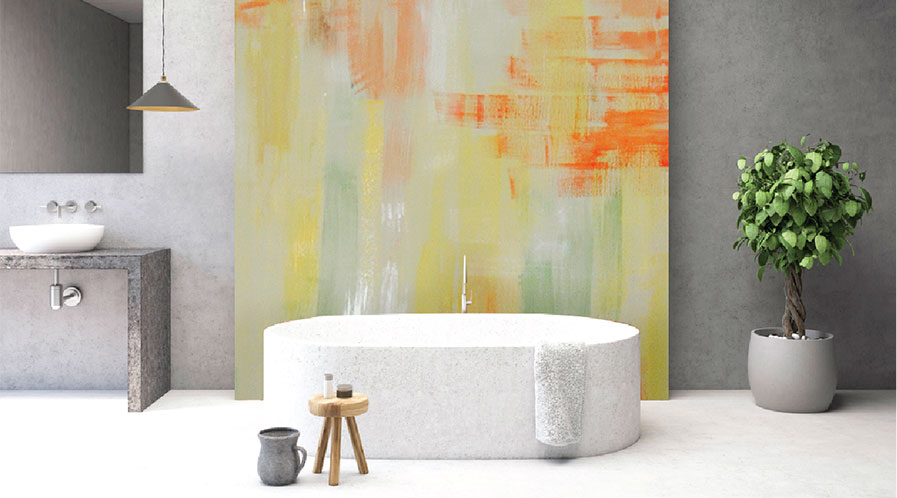
Ramesh Bhandari, Director, A-Class Marble adds, “Marble can be suitable for bathroom flooring and wall panels, but some notable considerations exist. Choosing a marble with good water resistance is crucial in bathrooms. Opting for marble stones with a lower porosity and better moisture resistance is recommended for bathroom use. Some marble and stone varieties commonly recommended for bathroom applications include Amazonite, Sodalite Blue, Emerald Quartz, Avocado, Statuario, Michel Angelo and Dover white.”
Marble is used in both flooring and wall applications, featuring intricate vein patterns that adorn surfaces, creating a truly exquisite bathroom atmosphere. Pairing marble flooring and walls with a free-standing or built-in bathtub crafted from the same marble material adds a seamless and luxurious touch to the overall bathroom design.
“Furthermore, marble’s versatility allows for its installation as wall coverings, vanity countertops, and even as sinks, creating a cohesive and visually appealing bathroom space that exudes sophistication and timeless beauty. To enhance safety and durability, bathroom floors can be treated with slip-resistant and stain-resistant finishes like honed, hydro and inciso to render a functional and low-maintenance surface,” shares Shah.

Amit Shah
Managing Director, Classic Marble Company
“Latest trends include designing captivating black and white bathrooms or incorporating contrasting marble with a blend of light and dark shades for a visually striking effect. The interplay of materials like marble and glass or marble and wood to add depth and texture to the space is also in vogue.”
Is Marble in Shower Area a Good Idea?
While the allure of marble is undeniable, there are two areas of concern for using this material in the shower area. First, marble is naturally porous and can be prone to staining and etching in high moister areas.
“Ensure proper sealing of the marble surfaces using a high-quality sealer designed for natural stone. This creates a protective barrier, reducing the marble’s absorbency and enhancing its resistance to stains. Also, regular maintenance and avoiding acidic or abrasive cleaners will minimise the chances of stains and etching,” states Shah.
Second, confronting the concern of slipperiness, especially in wet zones, is pivotal. “Selecting the correct type of marble for wet areas like bathrooms and shower floors is crucial to address slip resistance concerns. It’s essential to prioritise marble varieties with textured surfaces or finishes that provide better traction in such areas. One can opt for a brushed, leather, honed, or matte finish,” opines Bhandari.
Maheshwari adds, “Opting for marble treated with anti-skid measures furnishes it with added grip, mitigating slipperiness. Alternatively, finishes like leather and lapatura emerge as effective solutions, bestowing marble with textured surfaces that subtly counteract slipperiness while preserving its aesthetic charm. This thoughtfully crafted texture also introduces a delightful tactile element to the bathroom ambience, enhancing the overall sensory experience.”
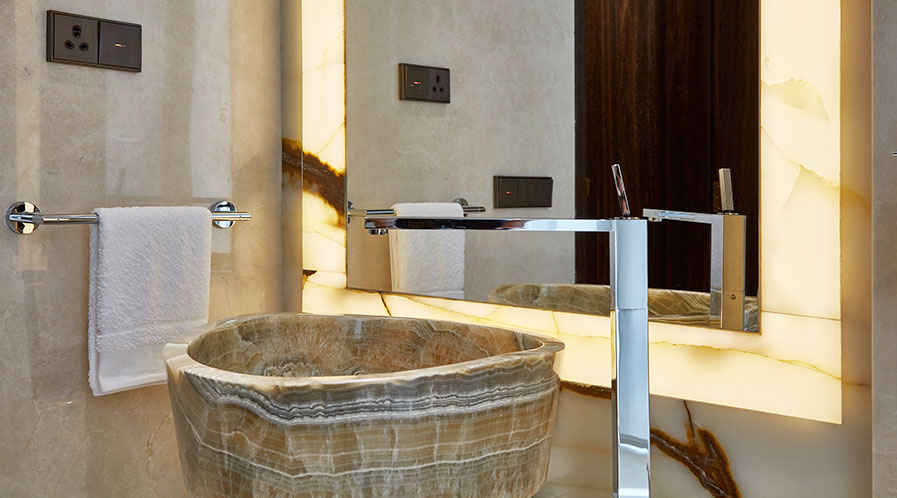
Talking about addressing the slipperiness, Shah informs, “CMC provides several types of marble finishes that include honed, hydro, inciso, and spazzola, among others. These finishes can be used for the washroom area to help mitigate slip hazards in wet areas. For instance, a honed finish provides a matte, smooth surface that offers better traction compared to polished marble. The slight texture of a honed finish can enhance slip resistance.”
Designers have also started using porcelain tiles mimicking the look and feel of marble in the shower area. “The choice between marble and porcelain tile in shower areas ultimately depends on personal aesthetic preferences and budget considerations. Marble can create a luxurious and enduring bathroom with regular maintenance. Additionally, natural marble is often treated with protective finishes; nanocoating and sealers to make it suitable for bathroom areas,” opines Shah.
Selection of Marbles: Compact vs Large Washrooms
The dimensions of a washroom undeniably influence material choices. “In spacious settings, stones boasting vibrant hues and intricate patterns emerge as recommendations, capturing attention and appreciation within the ample space. Conversely, such choices may project excessive strength and density within cosier confines. For compact bathrooms, brighter tones are favoured, ingeniously creating an illusion of expanded space. Larger bathrooms often embrace the symphony of multiple marble varieties, while smaller ones lean towards the simplicity of a single marble, harmonizing design with proportion,” recommends Maheshwari.

Rahul Maheshwari
Director, Marble Centre International
“Opting for marble treated with anti-skid measures furnishes it with added grip, mitigating slipperiness. Alternatively, finishes like leather and lapatura emerge as effective solutions, bestowing marble with textured surfaces that subtly counteract slipperiness while preserving its aesthetic charm.”
According to Bhandari, light-coloured marble stones like Michel Angelo, Statuario and Dover White can help create a sense of openness and brightness in contemporary washrooms with limited space. “Choosing marble stones with subtle veining can also prevent the design from feeling too busy in a compact area. One can also select a darker palette for spaces such as the powder room to create a distinct design language aligning with the home’s overall design style.”
Shah feels that white marble is a versatile choice that can be employed effectively in both large and small bathrooms to create a classic and inviting ambience. “In smaller bathrooms, it’s advisable to opt for white or light-coloured marble for flooring and walls as it can visually open up the space, creating an illusion of more room. Seamless installation of white marble, especially in larger slabs, contributes to a clean and elegant look.”
For larger and more luxurious washrooms, designers have more flexibility. “In such cases, bolder choices like Amazonite and Sodalite Blue marble stones create a striking focal point. The larger space allows for more intricate veining patterns without overwhelming the design. These marble stones can also be used for dramatic contrasts or as accent walls,” suggests Bhandari.

Ramesh Bhandari
Director, A-Class Marble
“Coloured marble and stones often exhibit intricate veining patterns that can further enhance the visual interest of the bathroom. These veins can be in complementary or contrasting colours, adding depth and texture to the design.”
Colour Play
Much like a painter’s palette, colour infuses vitality into interior spaces, and this vibrant essence resonates well with marble-clad bathrooms. “Marble copes exceptionally well with the trend of incorporating colour into bathroom spaces. While white marble has long been a classic choice for a timeless and elegant look, coloured marble stones are increasingly sought after for their ability to add vibrancy, uniqueness, and character to bathrooms,” opines Bhandari.
He further adds that there are various naturally occurring coloured stones available, such as Emerald Quartz, Sodalite Blue, Avocado, etc. “These stones can introduce colour into the space for bathroom surfaces, including floors, walls, and countertops. Additionally, coloured marble and stones often exhibit intricate veining patterns that can further enhance the visual interest of the bathroom. These veins can be in complementary or contrasting colours, adding depth and texture to the design.”
Maheshwari adds, “Exquisite shades of blue, enchanting pinks, deep greens, and daring lilacs flourish within marble, onyx, and quartzite, forging a captivating symphony of colours. This radiant trend resonates harmoniously with marble’s timeless legacy, welcoming a spectrum of shades that imbue bathroom interiors with newfound dimensions of elegance and character.”
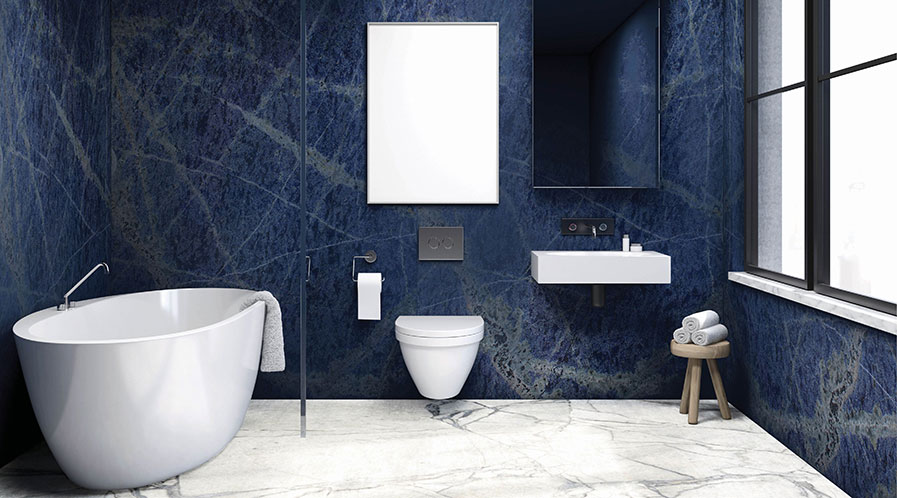
Carefully selected marble with unique veining patterns provides a canvas for creative expression. Designers can craft captivating contrasts, feature walls, and inlay designs with coloured marble, infusing vibrancy and character into the bathroom. “The trending colours lean towards oceanic hues, encompassing light and dark shades of blue and green, offering a natural touch for creating luxurious bathroom designs. The versatility of coloured marble, coupled with its innate sophistication, empowers designers to strike a harmonious balance between colour and classic luxury, rendering it an adaptable choice for contemporary bathroom designs that embrace vibrant hues,” remarks shah.
He further adds that engineered marble proves to be an excellent option for adding colour to bathrooms. “CMC’s Kalinga Stone marble and Terrazzo range marry the timeless elegance of natural marble with the flexibility of colour customisation. It not only boasts an extensive array of colour choices but also ensures consistency throughout the slab, which can be particularly advantageous when aiming for a uniform colour theme.”
Further, coloured marble and exotic stones can be used as accents or border tiles within a predominantly white or neutral marble design. This allows for a pop of colour without overwhelming the space.
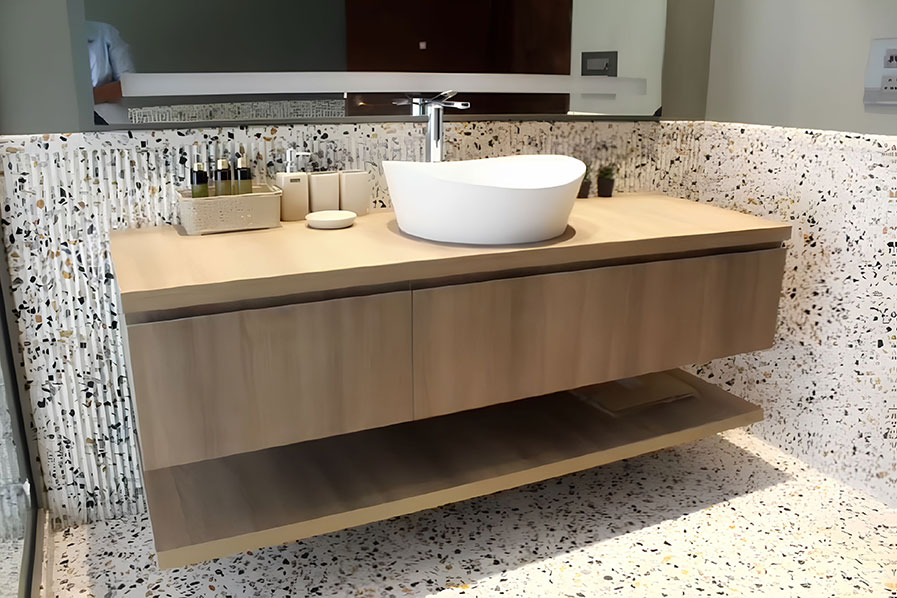
Being Creative with Marble
Marble has remained a mainstay in interior design, especially in bathrooms. Whether utilising a marble slab as a vanity countertop, opting for an all-marble floating sink or installing it on a floor or wall, designers can use the material in various stylish ways.
A soft modern look can be achieved with Statuario Marble. “Statuario marble, renowned for its pristine white surface graced with bold and distinctive grey veining, brings unparalleled luxury to any bathroom. It remains a symbol of enduring elegance, making it an ideal choice for those seeking to infuse their bathroom with timeless splendour,” opines Bhandari.
Emerald Quartz marble stone’s lush green hue and intricate veining reminiscent of semi-precious gemstones introduce a captivating and nature-inspired aura to a bathroom. “While it calls for diligent maintenance to protect its flawless allure, Michel Angelo marble symbolises enduring luxury, making it the perfect choice for those who aspire to bestow their bathroom with a touch of classical luxury and artistic allure,” adds Bhandari.
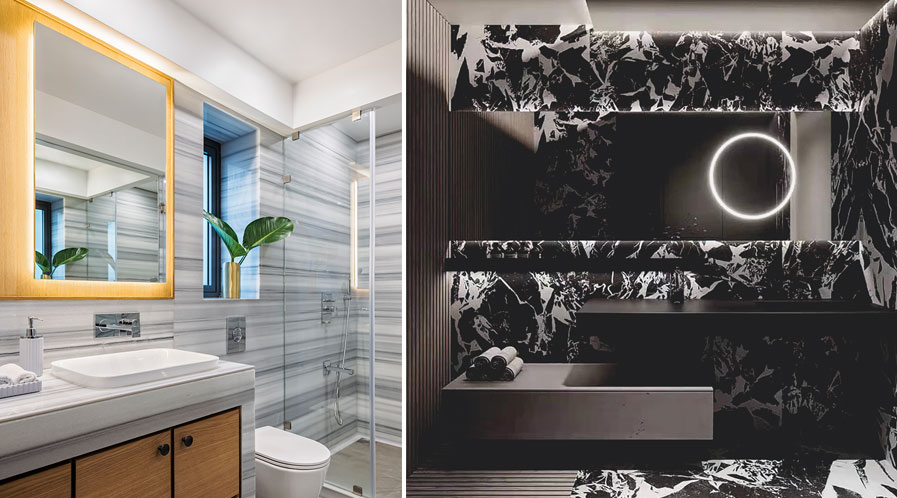
For a spacious and visually captivating washroom, Shah suggests, “Consider employing a combination of design techniques. Begin by utilising the book-match technique with two contrasting marbles for the walls. This creates a stunning mirrored effect that instantly draws the eye, adding a touch of opulence. For the flooring, opt for a mosaic pattern with the same marble varieties. The intricate design adds a layer of complexity and visual interest to the space.”
To further enhance the creative aesthetic, designers can incorporate terrazzo-fluted walls. “These vertical grooves not only lend a sense of architectural elegance but also play with light and shadow, adding depth to the room. Choose a neutral colour palette allowing the marble’s natural beauty to take centre stage creating an illusion of additional space,” recommends Shah.
Marbles certainly offer designers a world of creative possibilities. By employing various design elements in tandem, a washroom can be transformed into a luxurious, visually dynamic and seemingly larger sanctuary, where the interplay of marble patterns and textures elevate the overall aesthetic.
Tags: A-Class Marble, CMC, Luxury Bathroom, Marble, Marble Centre International



